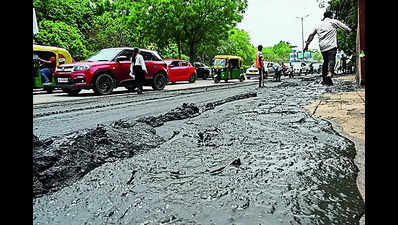- News
- City News
- delhi News
- New drainage system for Delhi need of the hour
Trending
New drainage system for Delhi need of the hour
Retired IAS officer Ramesh Negi emphasized the city's faulty drainage system, worsened by unplanned colonies, as a major concern.

While Shah directed the officials to maintain inter-department coordination, complete desilting of drains at the earliest and take temporary measures to solve local problems, officials maintained that the city will have to deal with waterlogging unless the city gets a new drainage system.They, however, agreed that it will take at least 4 years to put in place the new drainage set up that suits the requirement of the ever-growing population in both urban areas as well as the unplanned colonies of Delhi.
Delhi chief secretary Naresh Kumar said the city has been divided in three parts – Najafgarh basin, Barapullah basin and Trans-Yamuna basin – and consultants have already been appointed to prepare the drainage plan for each of them. “We are likely to get the report by March next year and once approved, it will take at least three years for modify the city’s drainage system as per the new plan,” Kumar said.
There are multiple agencies in Delhi that manage the city’s big and small drains while the high court has called for a single agency to look after them. With the current design of the drainage system, which was put in place almost 50 years ago in 1976, Delhi can easily drain only 50mm of rain in a day. However, the city came to its knees whenever it witnessed massive intense rains. On Friday, Delhi saw 228mm of rainfall and almost the entire city got submerged. In 2023, 153mm of rainfall was recorded on July 9 and 107.3mm on July 10, which led to widespread waterlogging across the city resulting in long traffic jams.
It was in 2009 that the then LG Tejendra Khanna had directed the civic bodies to prepare a master plan for the watershed and drainage system. The project was given to IIT-Delhi in 2012 . Almost five years since the report was submitted in 2018, a modern drainage master plan continues to evade the capital.
Retired IAS officer Ramesh Negi, who worked in MCD, Delhi Jal Board and Delhi govt’s urban development department said the city’s faulty drainage system was the making of everyone. “More than half of the city is unplanned. Go to the unauthorised colonies and villages and you will find the drains choked with garbage and construction waste. In posh localities such as Civil Lines, which was flooded after the Yamuna spilled over, Panchsheel, Hauz Khas and all others, drains have been covered to park vehicles,” Negi said. “I don’t blame the govt agencies. I blame the citizens for this problem,” he added.
Former additional director general in central public works department, MCT Pareva, who served in the irrigation and flood control department of Delhi govt twice as chief engineer, said the first spell of rain always leads to waterlogging. “Most drains are covered and difficult to clean. Also, our engineers are not trained to deal with the situation when it rains so much. The disaster management teams should conduct a drill before the monsoon to check if the system is fine,” Pareva said.
While he also advocated for a new drainage master plan for Delhi, Pareva said if the 1976 plan is properly implemented, the problem of waterlogging won’t occur.
End of Article
FOLLOW US ON SOCIAL MEDIA










